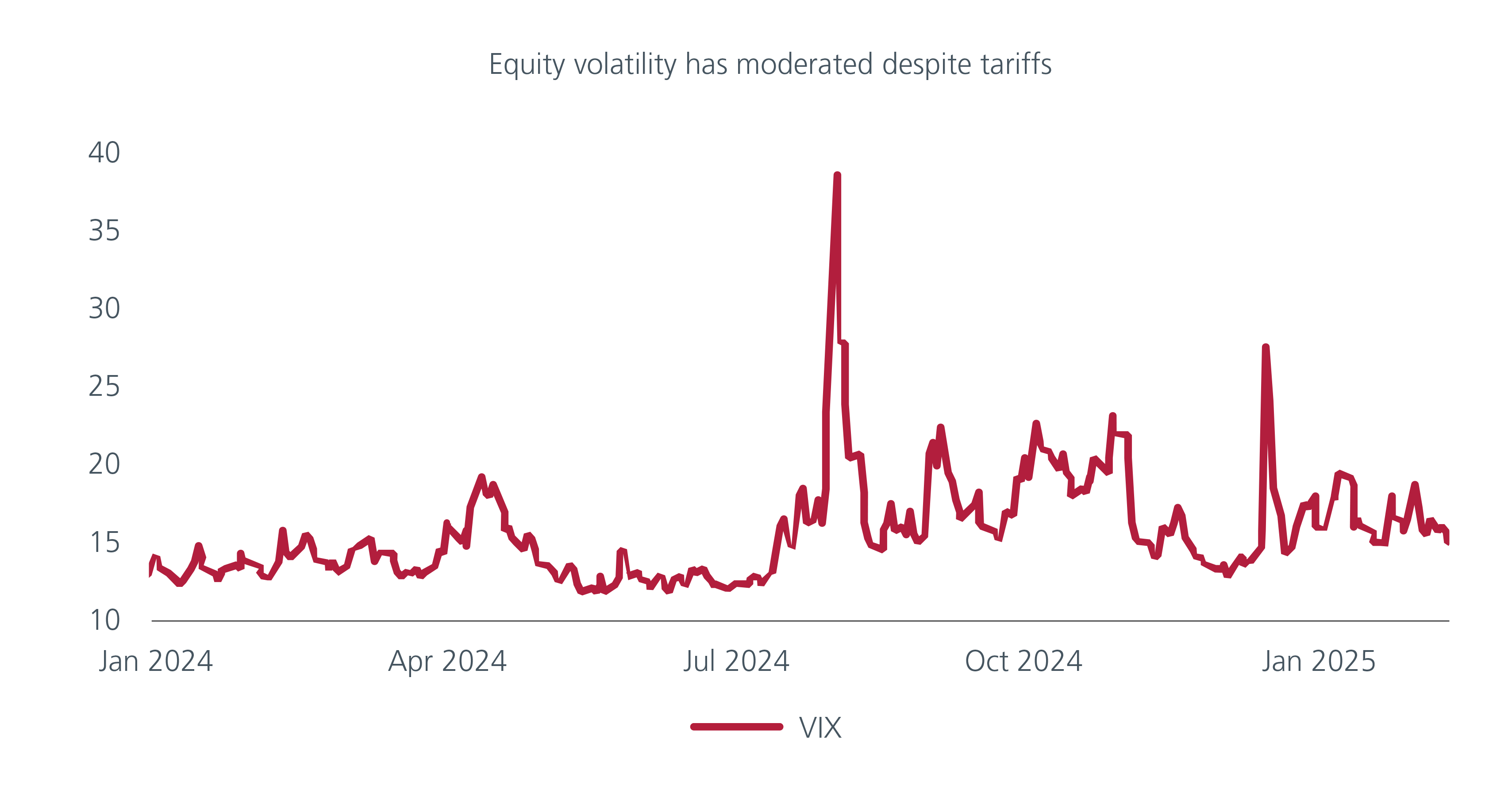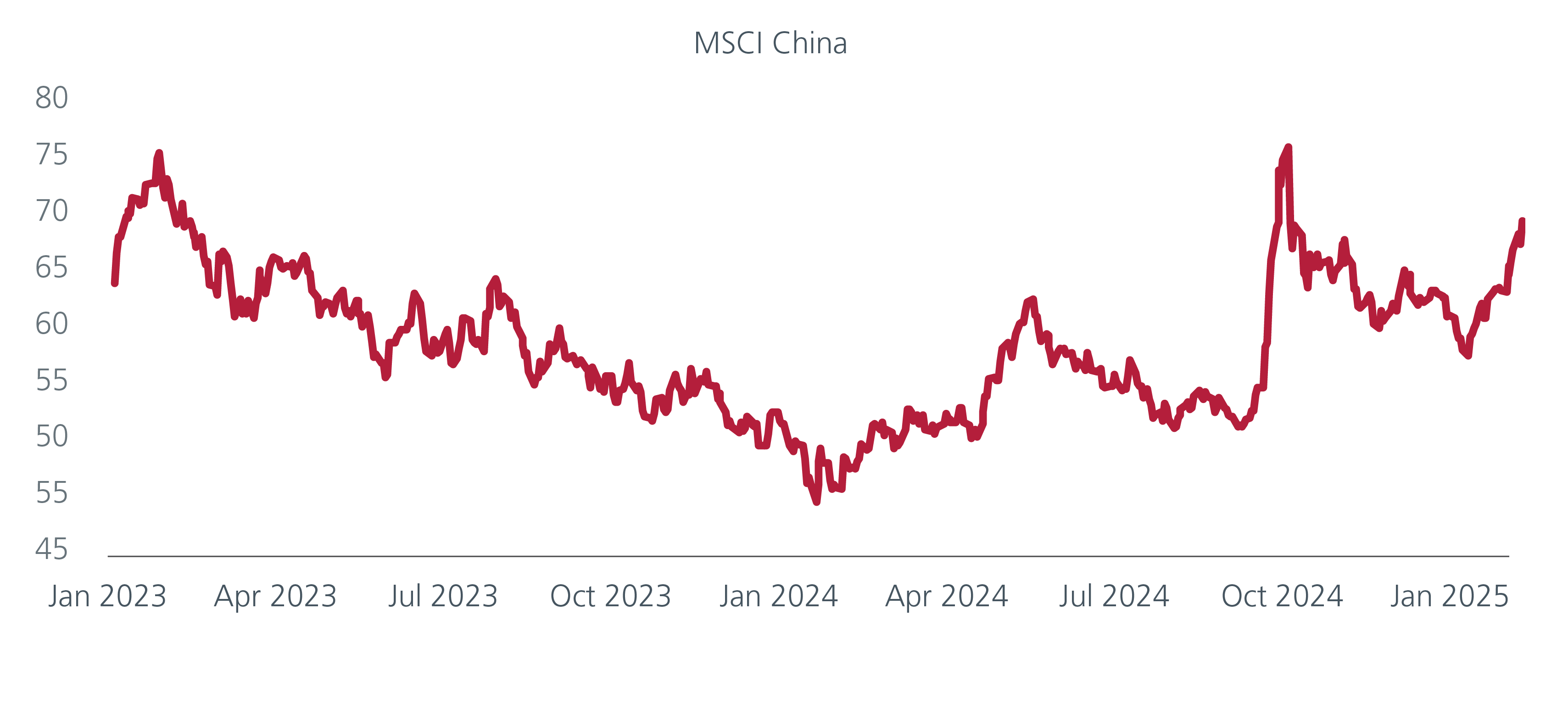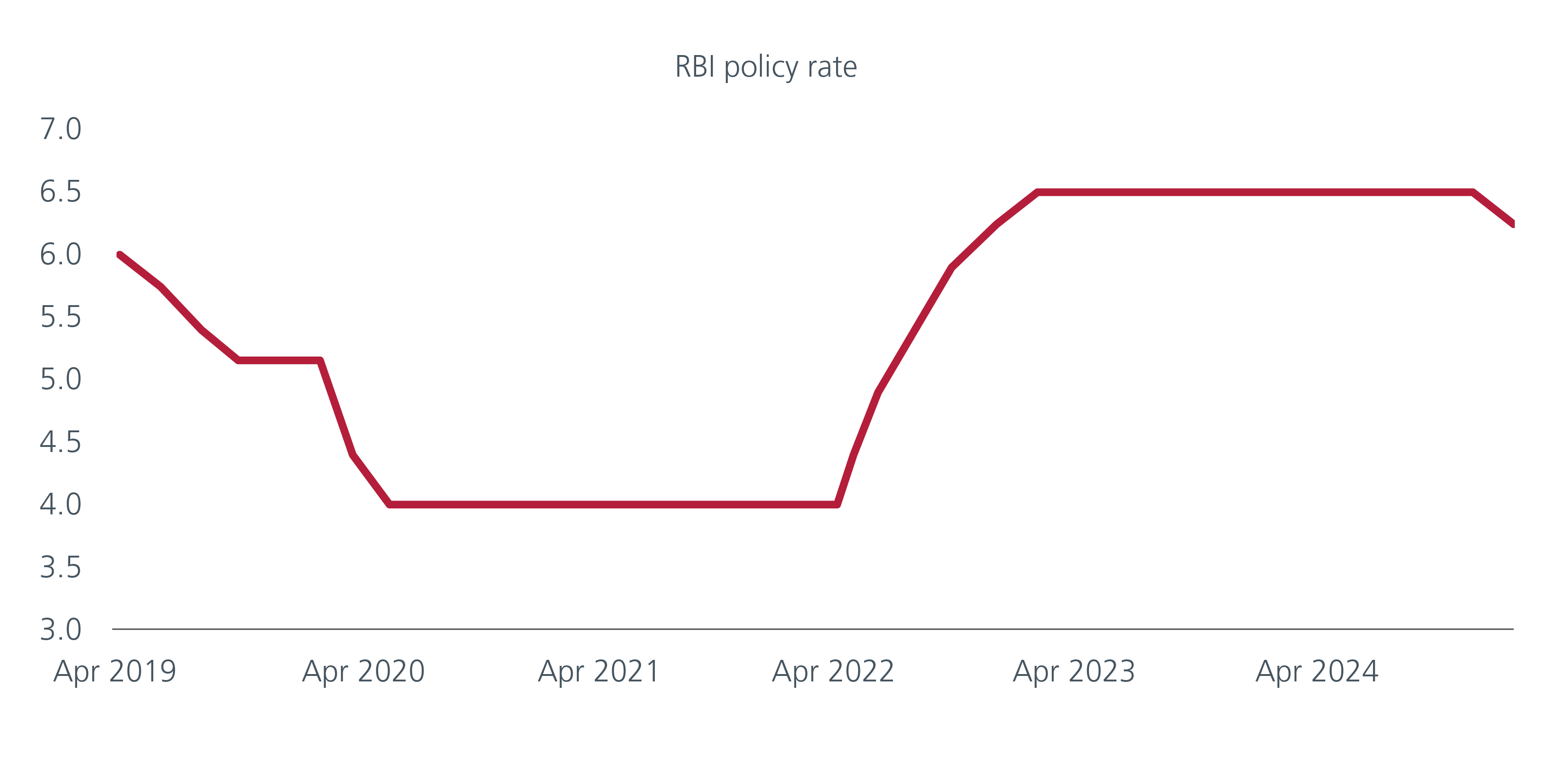Summary
Despite tariff uncertainty, better than expected earnings have kept asset market returns positive and market volatility moderate somewhat. China gets good news on property and AI while India begins monetary reflation.
What’s top of investors’ minds
Earnings work to offset uncertainty over tariffs and inflation.
Higher than expected US inflation in January has added to the uncertainty created by the Trump Administration's vacillations over tariffs. However, better than expected earnings have allowed asset market returns to remain positive and equity and bond volatility to moderate somewhat. With 383 constituents of the S&P 500 having reported at the time of writing, earnings are beating estimates by 6.5% with consumer discretionary and finance beating by 15.6% and 10.6% respectively. The recent fall in US initial jobless claims suggests that US employment and income growth will remain healthy in February, supporting real consumption growth of 3% - 4% in Q1 and so earnings growth. Similarly, faster than expected wage growth in Japan in December and expectations for a strong Shunto are helping Japanese earnings estimates to grind higher. In China, enthusiasm for new AI models has spurred a bounce up in earnings estimates
We think these trends should remain intact for the next couple of months. President Trump appears to be willing to delay most tariffs while he negotiates various issues with Mexico, Canada, and perhaps China. However, the clear risk is that if these break down he could choose to implement tariffs quickly. We estimate that tariffs on the scale that Trump has announced will slow both US and global growth, push up inflation, and cause further delays in Fed interest rate cuts.
Good earnings have helped equity returns and volatility

China gets good news on property and AI
Markets are currently giving China the benefit of the doubt on two fronts. First and most important for equities, the announcement of Deepseek and the subsequent announcement that Apple will use Alibaba AI for its phones in China have spurred upgrades to earnings estimates for China's tech sector. This should be a durable, although sector and company specific trend.
Another key positive has been a larger than expected government intervention into a large property developer in an effort to prevent it defaulting on maturing debt. If this proves successful it could become a blueprint for further, new government intervention into the property market. To be sure, this possibility remains highly uncertain at this stage.
Away from these, early indications for consumption growth during the Chinese New Year holiday season look mixed and overall slightly soft. We continue to think that deflationary pressure from China's property market will continue to weigh on the economy in absence of new fiscal stimulus. The government has signaled it will expand the public fiscal deficit this year meaningfully – we estimate by about 1.5% of GDP – but is choosing to wait to announce this at the "Two Sessions" in March and implement this stimulus in the following months. We judge this to imply indicators of domestic growth will slow somewhat in Q1 from the pick-up in Q4 even if export growth remains robust as companies try to front run US tariffs.
AI hopes boost Chinese equities

Monetary reflation has begun in India
The Reserve Bank of India cut its policy rate 25bps at its February meeting, as expected, and is continuing to inject liquidity into the financial system. We judge the RBI Governor Malhotra as biased to support growth with further easing and expect another 50bps of rate cuts this year with 75bps possible. Prime Minister Modi's rapid engagement of US President Trump also increases the likelihood that India will avoid significant US tariffs. Monetary easing needs to extend further with another cut in the next several months before it will impart a meaningful boost to growth. Our expectation is that Indian GDP will remain soft in Q1, begin to stabilise in Q2 and then begin to recover in Q3. We expect fixed income returns to benefit from easing ahead of equity returns, but remain constructive on the outlook for Indian equities over the course of the year.
More rate cuts needed to boost growth

The information and views expressed herein do not constitute an offer or solicitation to deal in shares of any securities or financial instruments and it is not intended for distribution or use by anyone or entity located in any jurisdiction where such distribution would be unlawful or prohibited. The information does not constitute investment advice or an offer to provide investment advisory or investment management service or the solicitation of an offer to provide investment advisory or investment management services in any jurisdiction in which an offer or solicitation would be unlawful under the securities laws of that jurisdiction.
Past performance and the predictions, projections, or forecasts on the economy, securities markets or the economic trends of the markets are not necessarily indicative of the future or likely performance of Eastspring Investments or any of the strategies managed by Eastspring Investments. An investment is subject to investment risks, including the possible loss of the principal amount invested. Where an investment is denominated in another currency, exchange rates may have an adverse effect on the value price or income of that investment. Furthermore, exposure to a single country market, specific portfolio composition or management techniques may potentially increase volatility.
Any securities mentioned are included for illustration purposes only. It should not be considered a recommendation to purchase or sell such securities. There is no assurance that any security discussed herein will remain in the portfolio at the time you receive this document or that security sold has not been repurchased.
The information provided herein is believed to be reliable at time of publication and based on matters as they exist as of the date of preparation of this report and not as of any future date. Eastspring Investments undertakes no (and disclaims any) obligation to update, modify or amend this document or to otherwise notify you in the event that any matter stated in the materials, or any opinion, projection, forecast or estimate set forth in the document, changes or subsequently becomes inaccurate. Eastspring Investments personnel may develop views and opinions that are not stated in the materials or that are contrary to the views and opinions stated in the materials at any time and from time to time as the result of a negative factor that comes to its attention in respect to an investment or for any other reason or for no reason. Eastspring Investments shall not and shall have no duty to notify you of any such views and opinions. This document is solely for information and does not have any regard to the specific investment objectives, financial or tax situation and the particular needs of any specific person who may receive this document.
Eastspring Investments Inc. (Eastspring US) primary activity is to provide certain marketing, sales servicing, and client support in the US on behalf of Eastspring Investment (Singapore) Limited (“Eastspring Singapore”). Eastspring Singapore is an affiliated investment management entity that is domiciled and registered under, among other regulatory bodies, the Monetary Authority of Singapore (MAS). Eastspring Singapore and Eastspring US are both registered with the US Securities and Exchange Commission as a registered investment adviser. Registration as an adviser does not imply a level of skill or training. Eastspring US seeks to identify and introduce to Eastspring Singapore potential institutional client prospects. Such prospects, once introduced, would contract directly with Eastspring Singapore for any investment management or advisory services. Additional information about Eastspring Singapore and Eastspring US is also is available on the SEC’s website at www.adviserinfo.sec. gov.
Certain information contained herein constitutes "forward-looking statements", which can be identified by the use of forward-looking terminology such as "may", "will", "should", "expect", "anticipate", "project", "estimate", "intend", "continue" or "believe" or the negatives thereof, other variations thereof or comparable terminology. Such information is based on expectations, estimates and projections (and assumptions underlying such information) and cannot be relied upon as a guarantee of future performance. Due to various risks and uncertainties, actual events or results, or the actual performance of any fund may differ materially from those reflected or contemplated in such forward-looking statements.
Eastspring Investments companies (excluding JV companies) are ultimately wholly-owned / indirect subsidiaries / associate of Prudential plc of the United Kingdom. Eastspring Investments companies (including JV’s) and Prudential plc are not affiliated in any manner with Prudential Financial, Inc., a company whose principal place of business is in the United States of America.





